|
Craig White's authors |
 Portrait by G. F. Watts (1870) |
William Morris (1834-96) News from Nowhere (1890) |
 |
William Morris's career conforms to Utopia seminar's Objective 1d. To identify the utopian author both within and beyond traditional literary categories—e.g., as writer + activist, agitator, reformer, prophet / visionary?
Morris is best known to literature today as author of a classic utopian novel, News from Nowhere (1890), but in his own time he was more widely known ias a poet, craftsman, architect, translator, printer, publisher, critic, preservationist, and later in life an activist for Socialist reform.
His continuous productivity on these fronts led a doctor, on hearing of Morris's death at age 62, to say, “[His] disease [was] simply being William Morris, and having done more work than most ten men.”
William Morris was born to a prosperous family in Essex, England, in 1834, three years before Victoria became Queen of the United Kingdom, and he died in 1896, five years after her passing, so he's understandably classified with authors like the Bronte sisters, George Eliot, and Thomas Hardy as a Victorian writer, but his florid subject matter may also be classified as a late Romantic author Tennyson, Swinburne, and Charles Dickens, all writing in the Victorian era.
Morris, like Samuel Butler, author of the satirical utopia Erewhon, originally studied to be a painter, and his literary style and circle of friends included members of the late English Romantic school of painters known as the Pre-Raphaelite Brotherhood, including Edward Burne-Jones and Dante Gabriel Rosetti. These painters' styles and subjects, like Morris's writings, depicted Medieval subjects in an intensely Romantic style featuring heavy detail, strong colors, and complicated compositions. In 1859 Morris married Jane Burden, who became a model for Pre-Raphaelite paintings.
|
|
|
(More Pre-Raphaelite art at bottom of page)
Working with Burne-Jones and other artists, Morris headed Morris & Company, which produced decorative materials as a fine art, inspiring the international Arts & Crafts Movement, which flourished in Europe and North America in the late 1800s-early 1900s, and in Japan in the 1920s.
Wallpaper produced by Morris & Company:
|
|
|
Rug & Tapestry designed by Morris & Co.
|
|
|
Architecture in Arts & Crafts style: Morris's self-designed "Red House" in London, and a bungalow in Jacksonville, Florida
|
|
|
The leading American exponent of the Arts & Crafts movement was Elbert Hubbard of New York State. His Roycroft settlement is a historical site.
Arts & Crafts Style Architecture
![]()
Morris as translator with Icelandic scholar Eiríkr or Eiríkur Magnússon (1833–1913) translated and published 6 volumes of the Saga Library, influencing the Victorian movement to study Old Norse and related languages and literatures.
Morris as printer founded the Kelmscott Press in 1891 to publish limited-edition, illuminated page editions of Medieval and Renaissance texts.
|
|
|
|
|
![]()
Literary interest in Morris faded during my studies but has revived recently due to his influence on Fantasy literature, particularly his early prose "Romances," his high fantasy novel The Well at the World's End, which influenced J.R. R. Tolkien and C.S. Lewis, and poetic works including The Defence of Guenevere (1857).
Morris was also notable for visiting Iceland and translating several Icelandic sagas.
Morris's later commitment to Socialism and authorship of News from Nowhere are consistent with his varied artistic career, all built on the model of the Middle Ages, a.k.a. the Medieval or Premodern era. (The name of the Pre-Raphaelite Brotherhood indicates their support for painterly values before those of Raphael, a leading Renaissance artist.) (See Periods.):
![]() Medieval village life as a model for modern living, in contrast to modern
cities. Middle Ages or Premodern era as lost
Medieval village life as a model for modern living, in contrast to modern
cities. Middle Ages or Premodern era as lost
![]() Medieval guilds as prototypes of craft unions from which workers could manage
local economies.
Medieval guilds as prototypes of craft unions from which workers could manage
local economies.
![]() Medieval crafts as meeting of daily work and art whereby labor becomes pleasant
and meaningful, as in the creation of art.
Medieval crafts as meeting of daily work and art whereby labor becomes pleasant
and meaningful, as in the creation of art.
![]() Medieval gothic architecture as public expression of community and spiritual
values (in contrast to impermanent, ugly, commercial structures of modern
capitalism).
Medieval gothic architecture as public expression of community and spiritual
values (in contrast to impermanent, ugly, commercial structures of modern
capitalism).
For literary and cultural studies, Morris represents a meeting point of aesthetic and Marxist theory and practice.
An important 20c biography, William Morris: Romantic to Revolutionary (1955, 1977) was written by E. P. Thompson (1924-1993), historian of radical movements of late 1700s-early 1800s; best known as author of The Making of the English Working Class (1963).
Thompson found Morris's work preserving English buildings from modern "restorations" sensitized him to relations between arts and society and took him on a journey toward radical Socialism.
197 . . . with every case that came forward he was given further and more horrifying insight into the insensibility of commercial philistinism, the absolute lack of any public conscience where questions of individual profit and loss were concerned. . . He was forced to contrast the attitude of feudal society in this respect with that of industrial capitalism.
199 What could be learnt from the monuments of past aspirations beyond the sense of mortality, and the bitterness and degradation of the present? The answer lay in that astonishing rebirth of hope which permeated all Morris's writing and activity in these years. The masterpieces of the past were not dead relics, but a living inspiration and warning to present, a proof of qualities in man which--however suppressed and slumbering--could not be extringuished for ever.
208 . . . all his researches into Gothic architecture and into the decorative arts reinforced his conviction that the true roots of thses arts were in the traditional skills of the people.
213 [following readings of Marx] In all his lectures he was moved . . . by his increasing understanding of the movement of history, of the fact of class division and the class struggle. If simplicity was the aim, its attainment would liberate ricch and poor alike.
from E. P. Thompson, William Morris: Romantic to Revolutionary, 1955, 1977. In Dorothy Thompson, ed., The Essential E.P. Thompson. The New Press, 2001.
![]()
News from Nowhere as utopian fiction: This semester I finally got around to reading News from Nowhere more from a sense of obligation than desire—the old graduate-student discipline of not claiming expertise until you've read absolutely everything in your chosen field.
Mrs. White asked why I was going to this trouble justr before retiring. I could only say it was the same crazy drive that first led me to study literature, so I may as well stay with it to the end in faith that the rewards outweight the pains, which turned out to be the case.
As with much classic literature and especially utopian fiction, studying a text often makes connections to other texts, in this case Edward Bellamy's landmark utopian novel Looking Backward, 2000-1887 (1887), which inspired the creation of Nationalist clubs in the USA urging "nationalization" of industries to serve the entire society rather than the wealthy only.
ch 7 analogy with army
cf. delivery of goods like Amazon
debit cards
street awnings anticipate mall
Morris, review of Looking Backward (Commonweal 22 June 1889)
para. 4 & 5 "alteration of machinery of life" + "mind fixed firmly on the mere machinery of life"
para 9: "Mr. Bellamy's ideas of life are curiously limited; he has no idea beyond existence in a great city; his dwelling of man in the future is Boston (U.S.A.) beautified. In one passage, indeed, he mentions villages, but with unconscious simplicity shows that they do not come into his scheme of economical equality, but are mere servants of the great centres of civilisation. This seems strange to some of us, who cannot help thinking that our experience ought to have taught us that such aggregations of population afford the worst possible form of dwelling-place . . . .
para 10: "In short, a machine-life is the best which Mr. Bellamy can imagine . . . . his only idea of making labour tolerable is to decrease the amount of it by means of fresh and ever fresh developments of machinery. I believe that the ideal of the future does not point to the lessening of men's energy by the reduction of labour to a minimum, but rather to the reduction of pain in labour to a minimum, . . . the true incentive to useful and happy labour is and must be pleasure in the work itself."
para 11: "individual men cannot shuffle off the business of life on to the shoulders of an abstraction called the State [i.e. Nationalism or nationalization], but must deal with it in conscious association with each other. That variety of life is as much an aim of true Communism as equality of condition, and that nothing but an union of these two will bring about real freedom."
Looking Backward cannot have been the only reason Morris wrote News from Nowhere, but Bellamy's book stimulated scores of responses and sequels, and News from Nowhere offers a counter-utopia that replaces machinery with natural organicism and cities with villages.
More immediate reasons for admiring News from Nowhere:
Like most utopian fictions, News from Nowhere starts slowly and features far more dialogue and ideas than action, but at length Morris's novel may have given me more immediate literary pleasure than any other strictly utopian novel, primarily because of the quality of its writing. As a Romantic Victorian author, Morris excels at the authoritative, slightly archaic, but idiomatic, quick-paced style we associate with the British Empire and its tales of high adventure in exotic places.
Nowhere's settings, both natural and artificial, feel personally intimate or dreamlike but also impressively direct and simple. It explores a land of never-was but rarely becomes falsely elaborate or long-winded. Despite its partial return of human society to a legendary past, the beauty represented by those principles appears honest and simple.
Character is never a strong point of utopian fiction, but Morris's career as a visual artist contributes to sharp, quick, evocative sketches of characters' appearances.
My first few reading sessions were more dutiful than engaged. Standard problems with utopian fiction didn't disappear, but the further I read, the more I found myself wanting to read without quite knowing why.
The quality of Morris's writing--the beauty of its prose and vision--somehow seems to prove its truth, that the creation and experience of beauty gives meaning to life and work.
![]()
Narrative structure for News from Nowhere bears features like that of other utopian noves: journey + dialogue
|
Chapters 1-8, opening journey: In "a brisk conversational discussion [at a London Socialist club] as to what would happen on the Morrow of the Revolutionan evening where a skeptical member , the narrator returns home for the night at his home in a London suburb, then wakes into a day and land that feel significantly different. The air is sweeter, the climate milder, and the outdoors abloom and uncrowded.
Like most utopian fictions, Morris's novel starts slowly, with an outsider from our world slowly coming to terms with a new utopian world. He walks to the Thames River near his home, where the traffic is light and he is given a ride on a rowboat by Richard (Dick) Hammond, a handsome, well-dressed young man wearing eccentric but attractive clothing.
Transporting people on the river is Dick's daily work, for which he, like everyone else at their jobs, is unpaid. He takes the narrator, soon known as "Guest," to a nearby house, where beautiful women including Clara, Dick's partner, serve them and another traveler a simple but nutritious breakfast.
Dick leaves his rowing duties to another man who enjoys similar work and conducts Guest on a horse-drawn farm wagon through a lightly populated "garden city" to the British Museum downtown. Through delighted observation and careful conversation Guest slowly becomes conscious that he has waked to a world some decades in the future. |
|
|
Chapters 9-19, dialogue between narrator and utopian authority figure: Most modern fiction presents a mix of represented action (narration) and reflective dialogue, but as a literature of ideas, utopian fiction often condenses the workings and historical backgrounds of its world in the form of extended conversations or dialogues between the visitor-narrator and a teacher, expert, or guide who answers questions, meets objections, and relates historical events and outcomes. In News from Nowhere, this dialogue, occupying the middle chapters of the book, takes place at the British Museum (right), where "Guest" (as the visitor is now called) talks with Dick Hammond's great-great-grandfather, "Old Hammond." At one point in Chapter 11 the dialogue is actually represented without narration, almost as a stage-script. Their dialogue concludes, however, with an extended narrative by Old Hammond of events surrounding a millennial revolution in which workers riot and eventually settle with the government on a new Socialist commonwealth. This riot is based on the "Bloody Sunday" riots of 1887 in London's Trafalgar Square, and resemble also the riot in Le Guin's The Dispossessed between workers and government military forces at Capital Square in Urras.
In an interesting off-stage development, at the start of the dialogue, Dick and Clara ask Old Hammond about the availability of a room in the British Museum, to which they go. When they reappear near the end of the interview, they appear to be in a sexual afterglow, at which the narrator remarks, "one had no feeling of shame in looking on at their little concealed love-making, for indeed it seemed as if all the world must be in love with them" (ch. XVI). |
 The British Museum, London |
|
Chapters 20-32 (end), concluding journey (with several stops) up the river to fields where numbers of people converge to reap hay.
As these people happily prepare a feast in an old church before the next day's work, Guest and Ellen wander to visit a home comparable to Morris's own country home, Kelmscott Manor (right).
When Guest returns alone to the church to join the company, he sees them but they don't see him. Presently he finds himself alone in the countryside, where he passes a poor, undernourished, subservient farmer and understands he has returned to his own time.
The novel concludes, "I lay in my bed in my house at dingy Hammersmith [London suburb] . . . trying to consider if I was overwhelmed with despair at finding I had been dreaming a dream . . . All along, though those friends were so real to me, . . . Yes, surely! and if others can see it as I have seen it, then it may be called a vision rather than a dream."
|
 |
The Dream-Vision features in prophecy and literature from the Bible's Book of Daniel through the first English proto-novel, Pilgrim's Progress (1678) by John Bunyan, whose journey to heaven (e.g., a utopian paradise) begins with the author dreaming a dream. (Atwood 72 dream vision)
Social issues represented or discussed in News from Nowhere
Ecological / Aesthetic
![]() Problem(s): Profit-motive commercialism has no motive to make
architecture beautiful beyond function of storing and selling merchandise;
industry increases profits by unloading wastes into common spaces of water, air,
and soil, despoiling environment and harming health. Increased and concentrated
human populations increase market-size and profits, also accelerating
competition.
Problem(s): Profit-motive commercialism has no motive to make
architecture beautiful beyond function of storing and selling merchandise;
industry increases profits by unloading wastes into common spaces of water, air,
and soil, despoiling environment and harming health. Increased and concentrated
human populations increase market-size and profits, also accelerating
competition.
![]() Solution(s): Disperse population from cities to villages. (Somehow)
reduce "reproductive desire," possibly by increasing life-spans and quality of
life. (Morris is indirect about such issues, but increasing quality of life and
education generally reduce birth-rates.)
Solution(s): Disperse population from cities to villages. (Somehow)
reduce "reproductive desire," possibly by increasing life-spans and quality of
life. (Morris is indirect about such issues, but increasing quality of life and
education generally reduce birth-rates.)
![]() Problem(s): Machinery and abstract economic systems determine social
relations, producing artificial desires beyond human needs.
Problem(s): Machinery and abstract economic systems determine social
relations, producing artificial desires beyond human needs.
![]() Solution(s): Organicism over machinery (Romantic principle);
human-scale communities, technology.
Solution(s): Organicism over machinery (Romantic principle);
human-scale communities, technology.
Garden City Movement; Achieved Utopias: Garden Cities
Looking Backward, 2000-1887 [3.61]
At my feet lay a great city. Miles of broad streets, shaded by
trees and lined with fine buildings, for the most part not in continuous
blocks but set in larger or smaller inclosures, stretched in
every direction. Every quarter contained large open squares
filled with trees, among which statues glistened and fountains flashed
in the late afternoon sun. Public buildings of a colossal size and an
architectural grandeur unparalleled in my day raised their
stately piles on every side. Surely I had never seen this city nor one
comparable to it before. Raising my eyes at last towards the horizon, I
looked westward. That blue ribbon winding away to the sunset, was it not
the sinuous Charles [River of Boston]? I looked east;
Chapter 2 Both shores had a line of very pretty houses, low and not large, standing back a little way from the river; they were mostly built of red brick and roofed with tiles, and looked, above all, comfortable, and as if they were, so to say, alive, and sympathetic with the life of the dwellers in them. There was a continuous garden in front of them, going down to the water’s edge, in which the flowers were now blooming luxuriantly, and sending delicious waves of summer scent over the eddying stream. Behind the houses, I could see great trees rising . . . .
Chapter 4: We turned away from the river at once, and were soon in the main road that runs through Hammersmith [district of west London]. But I should have had no guess as to where I was, if I had not started from the waterside; for King Street was gone, and the highway ran through wide sunny meadows and garden-like tillage. The Creek, which we crossed at once, had been rescued from its culvert, and as we went over its pretty bridge we saw its waters, yet swollen by the tide, covered with gay boats of different sizes. There were houses about, some on the road, some amongst the fields with pleasant lanes leading down to them, and each surrounded by a teeming garden.
Chapter 29. A Resting Place on the Thames. Presently at a place where the river flowed round a headland of the meadows, we stopped a while for rest and victuals [nourishment], and settled ourselves on a beautiful bank which almost reached the dignity of a hill-side: the wide meadows spread before us, and already the scythe [hay-cutting instrument] was busy amidst the hay. One change I noticed amidst the quiet beauty of the fields - to wit, that they were planted with trees here and there, often fruit-trees, and that there was none of the begrudging of space to a handsome tree which I remembered too well; and though the willows were often polled [trimmed], . . . this was done with some regard to beauty: . . . a thoughtful sequence in the cutting, that prevented a sudden bareness anywhere. To be short, the fields were everywhere treated as a garden made for the pleasure as well as the livelihood of all, as old Hammond told me was the case.
![]()
Work as pleasure
![]() Problem(s): alienation of labor, work-life division; how to motivate
labor without external reward of profit?
Problem(s): alienation of labor, work-life division; how to motivate
labor without external reward of profit?
![]() Solution(s) by other utopias: Twin Oaks, behaviorist communes,
Looking Backward: limit hours, distribute as rewards, compensations. In
The Dispossessed, the Anarresti rotate "tenth-day" labor to perform
important social activities.
Solution(s) by other utopias: Twin Oaks, behaviorist communes,
Looking Backward: limit hours, distribute as rewards, compensations. In
The Dispossessed, the Anarresti rotate "tenth-day" labor to perform
important social activities.
![]() Solution(s) in News from Nowhere: People do the work they are
naturally inclined to do, whether rowing on the river, providing hospitality and
housekeeping for guests, maintaining historical archives, or building finely
crafted homes and public buildings.
Solution(s) in News from Nowhere: People do the work they are
naturally inclined to do, whether rowing on the river, providing hospitality and
housekeeping for guests, maintaining historical archives, or building finely
crafted homes and public buildings.
The problems or contradictions raised by Morris's solutions are obvious and common to utopian planning or fiction. In the text itself, Dick repeatedly discusses how much he looks forward to joining others to harvest hay, and the latter part of the novel depicts their journey to the fields where this happens, but
A common problem in fairly all art and literature is that labor cannot be represented directly, but utopian fiction, by raising the issues of pleasurable labor, raises stakes and expectations that cannot be fulfilled, increasing the genre's risk of rejection as fantastic and unreal since it doesn't accept the "curse of labor" we've all grown used to since Adam and Eve were exiled from Eden or we grew up out of whatever leisure we enjoyed in childhood.
![]()
Women as property, labor, or subject or object?
![]() Problem(s): Morris's representations of women's identities or roles
struggle with familiar problems in Victorian standards. Do women achieve genuine
subjective equality as society modernizes and equalizes, or must they maintain
traditional roles supporting men and families?
Problem(s): Morris's representations of women's identities or roles
struggle with familiar problems in Victorian standards. Do women achieve genuine
subjective equality as society modernizes and equalizes, or must they maintain
traditional roles supporting men and families?
![]() Solution(s): Though some parents and their grown children appear as
characters in News from Nowhere, small children appear only in
glimpses, and no families with two parents and young children appear. Women,
freed like everyone from unpleasant labor, from individual ownership of
property, and from the strictures of marriage, live longer and maintain their
looks longer. For instance, Clara first appears as a young woman in courtship
with the young Dick Hammond, but it turns out that they were more or less
married at an earlier time. She broke off the relationship for another man, but
now she and Dick are renewing their relationship. In fact they are around 40
years old but look and act like fresh sweethearts.
Solution(s): Though some parents and their grown children appear as
characters in News from Nowhere, small children appear only in
glimpses, and no families with two parents and young children appear. Women,
freed like everyone from unpleasant labor, from individual ownership of
property, and from the strictures of marriage, live longer and maintain their
looks longer. For instance, Clara first appears as a young woman in courtship
with the young Dick Hammond, but it turns out that they were more or less
married at an earlier time. She broke off the relationship for another man, but
now she and Dick are renewing their relationship. In fact they are around 40
years old but look and act like fresh sweethearts.
Though women in News from Nowhere often appear humoring or serving men, Morris added a chapter to the first book-publication (Chapter 26. The Obstinate Refusers) that featured women workers at a construction site. The first woman they meet is a model for the sculptors on the site. Another middle-aged (but still youthfully-beautiful) model appears, but her mother is Philippa, the chief carver for the builders, who is friendly enough but won't stop her work to socialize with Guest and his fellow visitors. She appears totally dedicated to her artistic work, and her fellow-workers defer to her commands and eccentricities.
The most problematic yet attractive woman character in News from Nowhere is Ellen, a 20-year-old whose beauty is distracting and reminiscent of the Pre-Raphaelites' paintings of women:
"We went up a paved path between the roses, and straight into a very pretty room . . . the chief ornament of which was a young woman, light-haired and grey-eyed, but with her face and hands and bare feet tanned quite brown with the sun. . . . her gown was of silk, and on her wrists were bracelets that seemed to me of great value. She was lying on a sheep-skin near the window, but jumped up as soon as we entered, and when she saw the guests behind the old man, she clapped her hands and cried out with pleasure, and when she got us into the middle of the room, fairly danced round us in delight of our company."
The next day . . .
"I looked, and over the low hedge saw Ellen, shading her eyes against the sun as she looked toward the hay-field, a light wind stirring in her tawny hair, her eyes like light jewels amidst her sunburnt face, which looked as if the warmth of the sun were yet in it."
Ellen risks being a "manic pixie dream girl," (2), but Morris gives her a serious voice, which may resemble that of a prophetess or sibyl, as she laments the pain of Morris's present time, when she herself would have had little freedom to determine her own fate and would have had to marry for money instead of love.
Ellen's and Guest's relationship remains unresolved. They row together to the hay-fields. He develops a careful and respectful crush on her. She suggests that he might live with her and her grandfather in their new home up-river.
As a character Ellen represents all that is desirable about the utopian future: beauty, seriousness, care in living, which makes their separation in the final scene potentially aching:
Guest enters the church where the workers' feast is beginning:
"I stood on the threshold with the expectant smile on my face of a man who is going to take part in a festivity which he is really prepared to enjoy. Dick, standing by me was looking round the company with an air of proprietorship in them, I thought. Opposite me sat Clara and Ellen, with Dick’s place open between them: they were smiling, but their beautiful faces were each turned towards the neighbours on either side, who were talking to them, and they did not seem to see me. I turned to Dick, expecting him to lead me forward, and he turned his face to me; but strange to say, though it was as smiling and cheerful as ever, it made no response to my glance—nay, he seemed to take no heed at all of my presence, and I noticed that none of the company looked at me. A pang shot through me, as of some disaster long expected and suddenly realised. Dick moved on a little without a word to me. I was not three yards from the two women who, though they had been my companions for such a short time, had really, as I thought, become my friends. Clara’s face was turned full upon me now, but she also did not seem to see me, though I know I was trying to catch her eye with an appealing look. I turned to Ellen, and she did seem to recognise me for an instant; but her bright face turned sad directly, and she shook her head with a mournful look, and the next moment all consciousness of my presence had faded from her face."
As with fairly all Romantic literature, loss only makes desire stronger for what was glimpsed.
As Morris concludes, "if others can see it as I have seen it, then it may be called a vision rather than a dream."
![]()
Pre-Raphaelite Brotherhood or Pre-Raphaelites
"Pre-Raphaelite" = "before Raphael," leading Renaissance artist, reflecting group's dedication to Medieval themes and values
(1850s-1890s?)

John Everett Millais, Ophelia (1851-2)
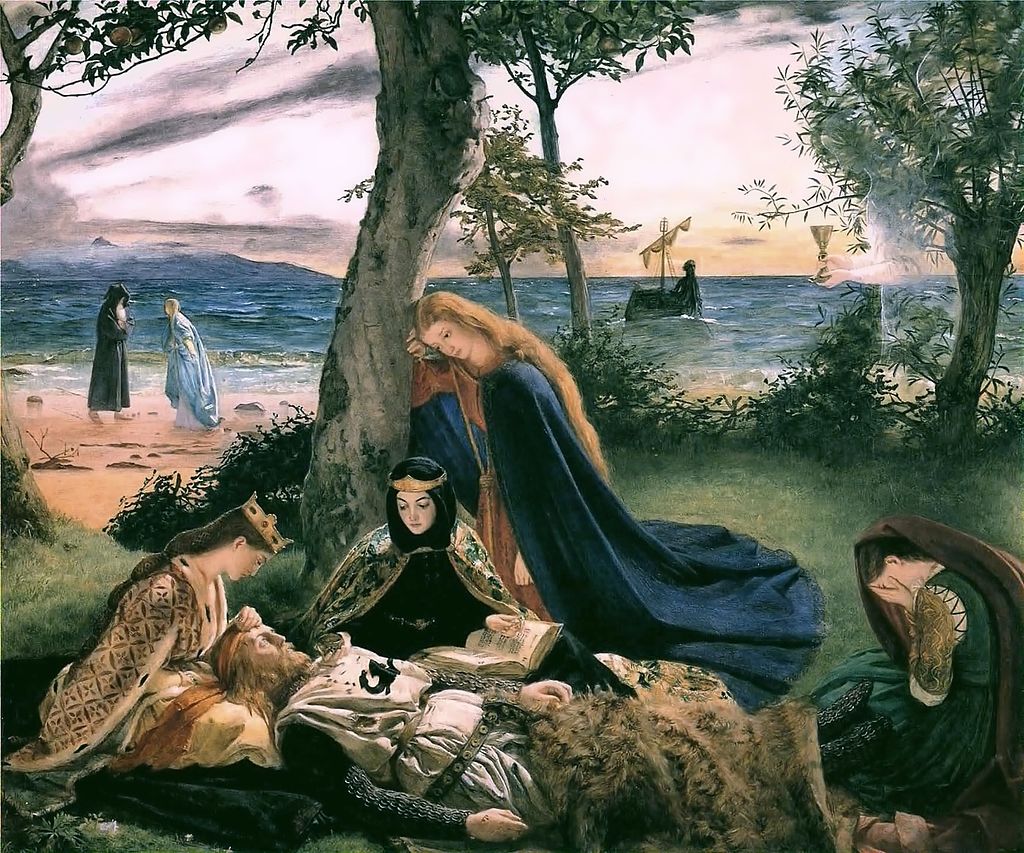
James Archer, The Death of King Arthur (1860)
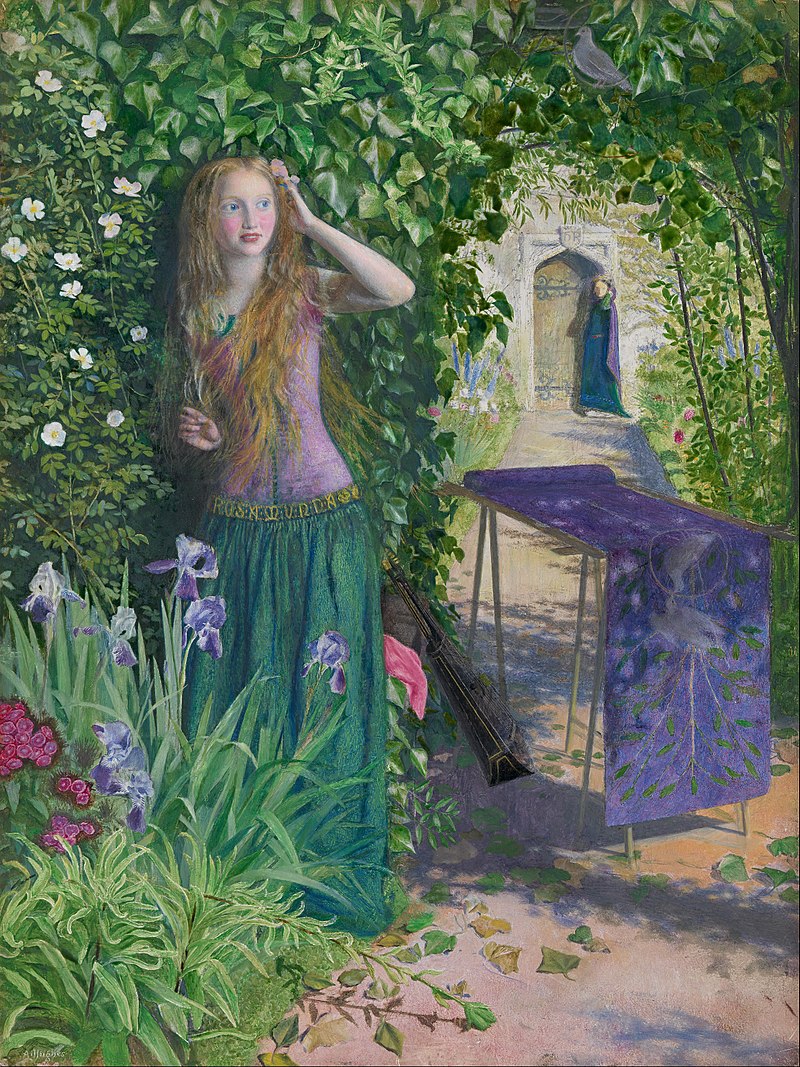
Arthur Hughes,
Fair Rosamund (1854)
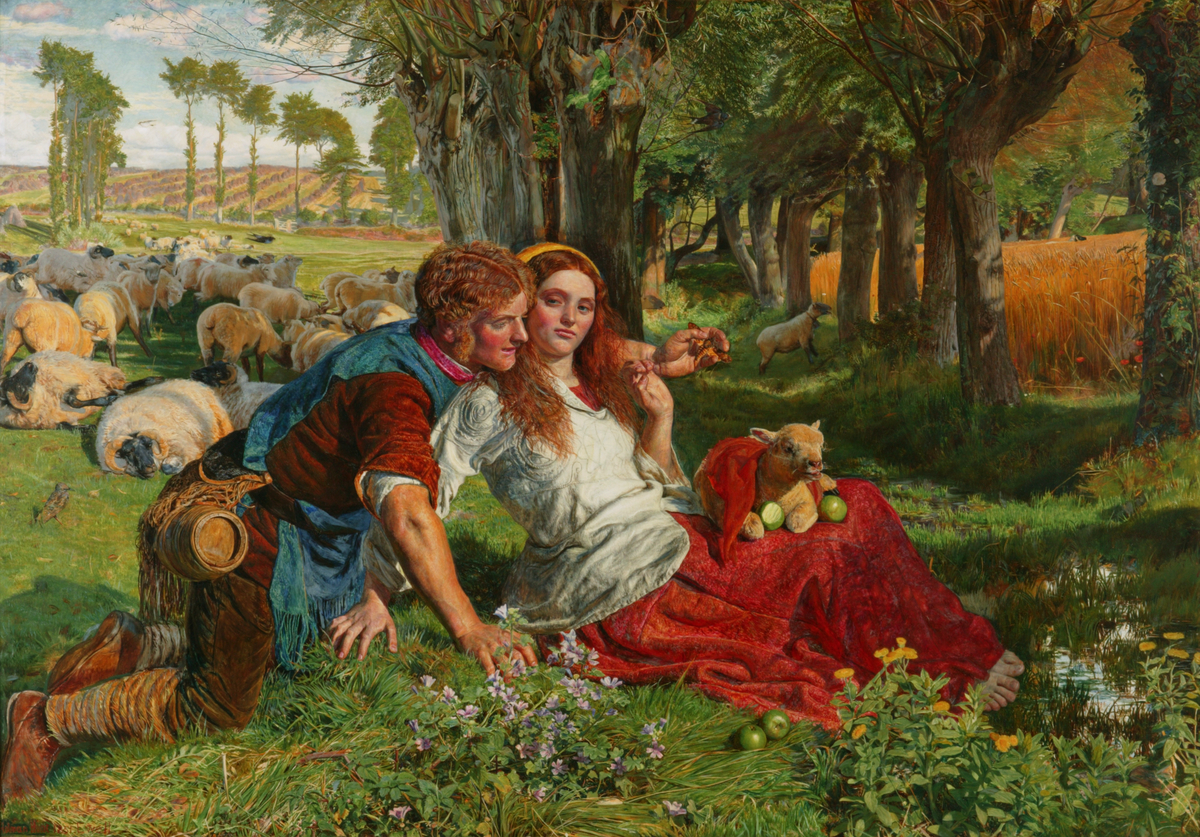
William
Holman Hunt, The Hireling Shepherd (1851)
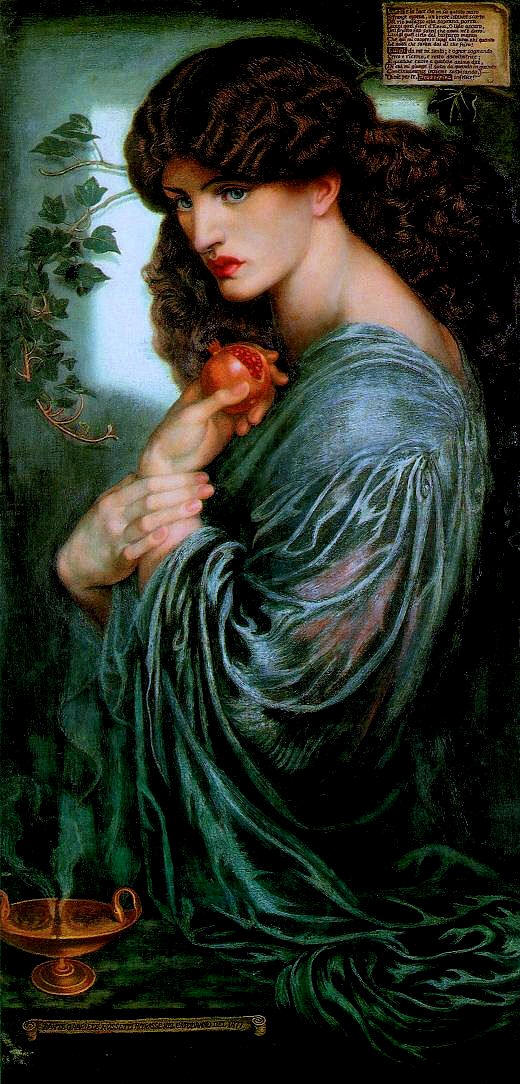
Dante Gabriel Rosetti,
Proserpine
(1874)
modeled by Jane Burden Morris
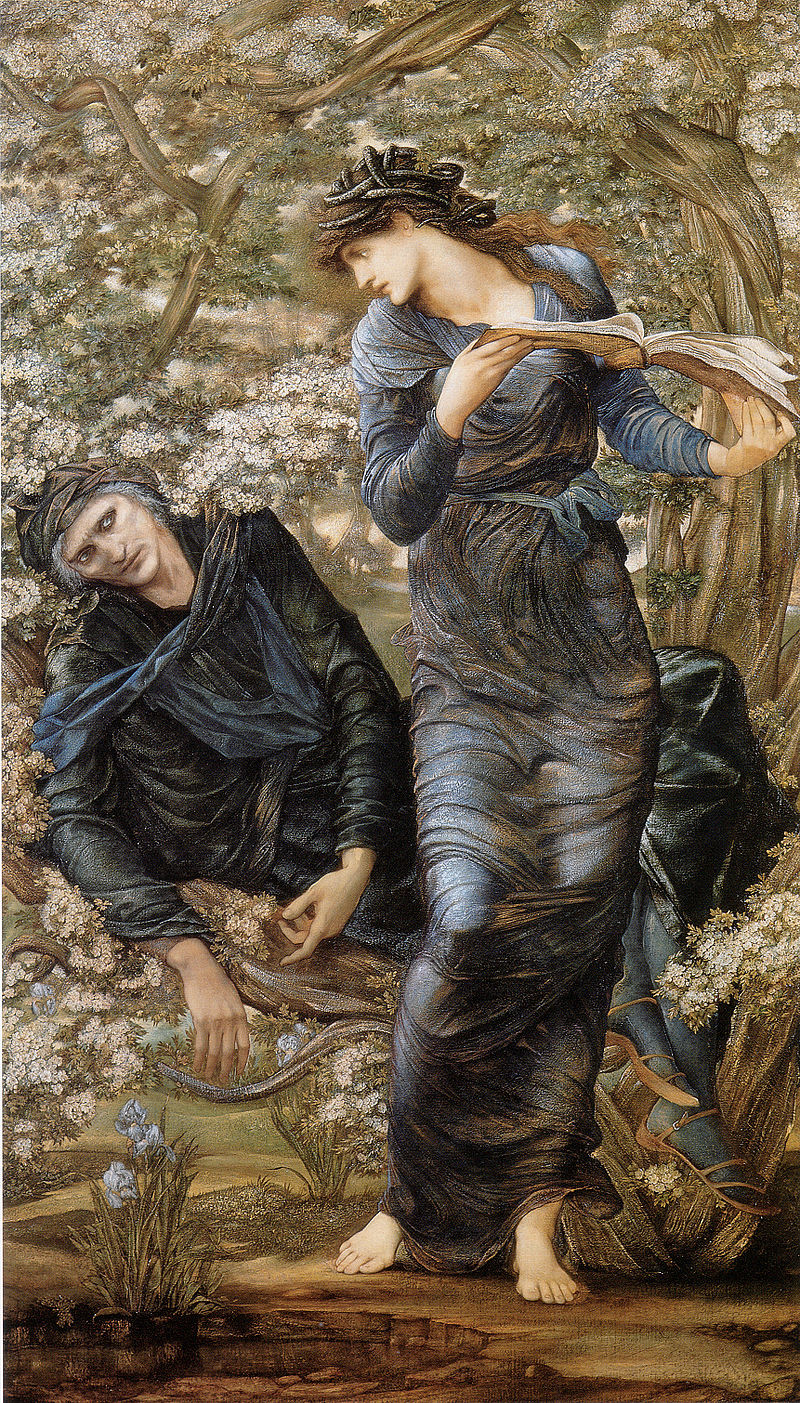
Edward Burne-Jones, The Beguiling of Merlin (1874)

Christina Rossetti, by brother Dante Gabriel Rossetti

William Holman Hunt, The Light of the World
(Christina Rossetti facial model)
Christina Rossetti: Poetry in Art
|
|
|
Reproductive desire programmed into humans as part of survival of species
Men's desire for young women natural, as is young women's disdain for older men.











